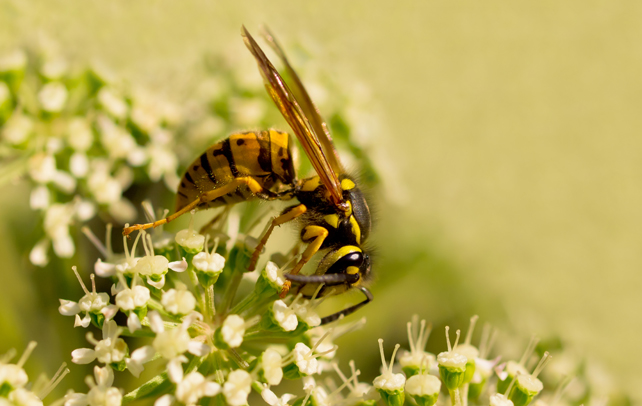Fun Facts About Wasps

Ever wondered how many different species of wasps can exist in the world? Well, the answer is 100,000. In fact, the number actually surpasses this count. Often confused with bees, in general, but wasps do exhibit a couple of differences when compared to bees. While wasps have slender bodies, narrow waists and appear to be shiny, bees, on the other hand, have a hairier body. What’s more, a bee sting remains embedded in the skin of its prey, while a wasp can sting a human multiple times, which contains a powerful venomous punch. Ranging from metallic blue to bright red to yellow to brown, wasps are found in all colours one can imagine. This medium sized flying insect has a global presence with the exception of arctic and sub arctic regions. A comprehensive list of interesting facts and amazing information on wasps waits to be discovered. Browse through the following section to uncover various details on the wasp.
Fast Facts
Kingdom: Animalia
Phylum: Arthropoda
Class: Insecta
Order: Hymenoptera
Suborder: Apocrita
Species: More than 100,000 species
Size: 5-15mm
Weight: 1 gram
Lifespan: 12-22 days
Diet: Nectar, insects, caterpillars, fruits
Habitat: Worldwide, except Polar Regions
Number of Offspring: 25
Interesting And Fun Facts About Wasps
- Wasps can be classified in two broad categories: solitary wasps and social wasps.
- While social wasps account for just a thousand species, solitary wasps form the largest subgroup.
- The Asian Giant Hornet is the largest wasp in the world, with a body length of 50 mm (2 inches) and wingspan of 76 mm (3 inches). Also, it has a sting measuring 6 mm (0.2 inches), allowing it to inject a large amount of powerful poison in its prey.
- Cicada killers and striking blue-and-orange tarantula hawks are other large members of the wasp family.
- The most commonly spotted wasps include yellow jacket wasps, paper wasps and bald faced hornets.
- Unlike bees, wasps do not make honey, but some species help in the pollination of plants.
- When a wasp dies, it emits a pheromone in the air which acts as a warning signal to other wasps so that they become aware of the danger and come to help their fallen comrade.
- Wasps do not store food; hence, during hibernation, the queen relies on her own body fat to survive.
- They do not produce wax. As such, their nests are made of a paper-like substance made of chewed wood and plants. However, some species use mud also.
- While social wasps live in nests inhabited by 5,000-10,000 wasps at one time, solitary wasps do not construct nests and live alone.
- Not all social wasps are fertile unlike solitary wasps where each one can reproduce.
- The female yellow jacket wasp is known to lay both fertilized and unfertilized eggs.
- A wasp queen is easily recognizable since it is larger than both males and females in the nest.
- The queen is the only fertile female in a wasp nest and can lay eggs while the rest of the sterile females become workers and take care of the eggs.
- A female wasp has a stinger, which is actually a modified egg-laying organ, while her male counterpart does not. Therefore, female wasps guard and protect the nest against danger.
- Every spring, the queen wasp, who has survived the cold, starts creating colonies from scratch. She first builds a nest and begins a family of worker females. Thereafter, the nest is expanded and eggs are laid. Eventually, the colony is filled with more than 5,000 individuals by late summer and by winter, most of them, including the queen, die. This process is then restarted at spring.
- Wasps scavenge food for their young larvae and in return, the young produce sweet secretion which is eaten by the adult wasps.
- Wasps are omnivores and usually feed on nectar, carrion, honey and fallen fruit. Besides, they also look for insects and large caterpillars as their food.
- Most aggressive behavior among the wasps is displayed during the months from August through October where their food habits change. It is during this period that they are known to attack humans as well.
- Wasps are food gatherers and can travel up to 400 meters in order to procure food.
- Most male wasps do not hibernate and as a result die at the onset of winter.
- Wasps are not nocturnal creatures and hence, carry out all their activities during day and return to their nests at night.
- A female that lays its eggs first and protects them from other females while constructing the nest becomes the queen and if a queen dies, she is replaced by some other female.
- Wasps are natural predators of caterpillars and thus, a friend to farmers.
- Birds, amphibians, reptiles and several other species of mammals forulm the predators of wasps due to their bright and attractive colours.









